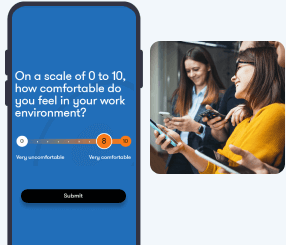What if there was a way to measure employee engagement, identify potential problems before they escalate, gather feedback, and help people feel heard in your company, all in one step?
Enter pulse surveys. A pulse survey is the most simple, yet powerful tool that you can use to measure employee and team engagement on the spot. Discover how you can gather feedback quickly, and on a recurring basis with this complete guide to pulse surveys.
What is a pulse survey?
A pulse survey is a survey that is conducted on a recurring basis and tends to be between 1-15 questions long. The goal of a pulse survey is to quickly collect valuable feedback on a specific topic from a target group of respondents. As a result, one of the distinct characteristics of a pulse survey is that all of the questions included will focus on a single, specific topic.
Pulse surveys get their name from the idea that they are used to “take the pulse”, or gauge how employees and teams are feeling about a particular topic or issue. The most effective pulse surveys give you clear insights on the issue at hand.
For this reason a good pulse survey should take no more than a few minutes to complete. When a survey is too long or complicated, respondents will reach a point where they just want to get it over with. The result is that the quality of responses to questions declines as they go on, and the data you ultimately gather loses its accuracy.
It’s common practice for a pulse survey to consist of basic yes or no questions, or rating questions that are quick to answer. You can also deliver a pulse engagement survey, which can take on the form of an open ended question. If you do ask a question that allows respondents to type in their feedback then it’s good practice to limit these to just one or two questions. Because these take more effort to answer, it’s better to opt for quality responses, rather than a huge quantity of responses
When is it a good time to administer an employee pulse survey?
After a major change in the organization
If your company or organization has recently undergone a major change, such as a reorganization or a shift to remote work, a pulse survey can help you understand how employees are adapting to the change and identify any challenges or concerns. We all know that most people don’t like change, so understanding how your team is responding is critical to a smooth transition.
Pro tip: Send out the same pulse survey to your team two weeks after the major change, then again after two months, and then again after six months. This will allow you to compare how responses do or don’t change over time. If the change in your company was ultimately for the best, then you’ll likely see that those who were most unsatisfied in the beginning will have come around six months down the line. If, however, team members remain consistently unhappy, then it might be time to seriously reevaluate the initial decision.
Before making a decision
Speaking of decisions, if your organization is considering making a significant decision, such as launching a new product or changing a policy, a pulse survey can help you gather employee feedback and insights ahead of time.
It’s natural that decisions in a company come from the top down. It’s also natural that the decision makers have very different perspectives than the rest of the employees in the company. That’s why it’s always a good idea to check your blind spots, and ask for feedback from those who will be impacted the most— it’s not unlikely that these team members will bring points to your attention that you hadn’t considered before.
During times of uncertainty or stress
If your organization is going through a period of uncertainty or stress, such as during a crisis or a period of rapid growth, a pulse survey can help you understand how employees are coping and identify any areas where support may be needed.
Keep in mind that even if your company is doing well, your employees may be affected by external factors or global events that are beyond yours, and their control. By simply checking in with people and asking how they’re doing, you create a culture of empathy and understanding that makes people want to stay.
On a regular basis
Regardless of whether there is a specific event or issue to address, it can be helpful to administer pulse surveys on a regular basis, such as quarterly or bi-annually, to monitor employee engagement and satisfaction over time.
There’s nothing wrong with checking in, and taking the pulse, of your organization from time to time. It might even help you preemptively identify problems, and solve them before they escalate needlessly.
Examples of pulse survey questions
You can use pulse surveys to get feedback from employees on anything ranging from their general satisfaction and happiness at work, to very specific initiatives that are unique to your company. Here are some sample questions that you can use today to start gathering insights:
Employee satisfaction and engagement:
- On a scale of 1 to 10, how satisfied are you with your job?
- On a scale of 1 to 10, how engaged are you with your work?
- What is one thing your manager could do to improve your job satisfaction or engagement?
Communication and feedback:
- On a scale of 1 to 10, how well does your manager communicate with you?
- How often do you receive feedback on your work performance?
- On a scale of 1 to 10, how comfortable are you providing feedback to your manager?
Work environment and culture:
- On a scale of 1 to 10, how comfortable do you feel in your work environment?
- Do you feel that your work environment promotes collaboration and teamwork?
- On a scale of 1 to 10, how well do you feel your company’s values align with your personal values?
Change and innovation:
- How do you feel about recent changes or initiatives at the company?
- On a scale of 1 to 10, how innovative do you feel your team is?
- What is one thing you would change about the way your team approaches innovation?
You can use these questions as is, or you can tailor them to your organization’s specific initiatives and goals. It’s important to keep your survey short and focused to maximize response rates and ensure that the feedback is actionable.
Send out pulse surveys with the click of a button

What are the benefits of administering employee pulse surveys?
There are several benefits to administering employee pulse surveys, including:
Quick feedback: Pulse surveys are short and easy to answer and allow companies to gather vital information in a short amount of time, which can be helpful for identifying and addressing problems in a timely manner. This also benefits the employees as they don’t have to spend hours filling out long surveys to have their voice heard, and they know that their opinions and feedback will be seen within a day or two, if not a few hours.
Informed decision-making: Before making any large decisions, companies can see how their employees will react to these projected changes, or provide valuable insight as to why the decision would make the environment better or worse.
Improved communication: By asking for employee feedback, organizations can encourage open communication and dialogue between employees and management, which can help build trust and improve overall communication.
Increased engagement: By regularly asking employees for feedback your company demonstrates that it values employee input and is committed to creating a positive work environment. In turn, this improves employee engagement and satisfaction.
Retention and recruitment: Pulse surveys help organizations identify areas where improvements are needed to retain employees and make the organization more attractive to prospective employees.
Cost effective: The actual process of sending out a pulse survey costs virtually nothing. And since they’re quick to complete they don’t cost your employees or company a lot of precious working time. Some low-cost tools can also automate the surveys, gathering and interpreting the data, which further reduces the need for timely administration and evaluation.
FAQs
Do pulse surveys work?
Yes! A well constructed pulse survey will give your company valuable insight into their employees’ overall satisfaction, ability to handle their workloads, and how they respond to changes. Because pulse surveys are sent out frequently and address a specific topic, you can see how employees’ opinions and feelings change toward these specific topics over a period of time.
What makes a good pulse survey?
A good pulse survey contains short, and specific questions that are easily understood and can be answered quickly, such as on a scale of 1-10, or with yes or no answers. You should be able to quickly interpret the results and plan your actions after evaluating what employees had to say.
How do you take a pulse survey?
A pulse survey can be sent to the employees via email, an app or by utilizing online platforms for the quickest and best results. Avoid trying to use the pen-and-paper method as this creates an opportunity for lost surveys, human errors, and excessive time use.
Key takeaways
- Pulse surveys are used to quickly gather insight into your company’s well-being and that of its employees.
- Employee pulse surveys allow you to see how well your employees are responding to change or the lack thereof.
- By using a pulse survey, you can understand how you need to implement changes to ensure your employees are feeling supported and happy, allowing for increased productivity and a healthier environment.


